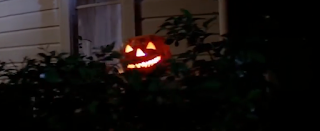Tuesday, 24 January 2017
Wednesday, 18 January 2017
Wednesday, 11 January 2017
Halloween opening scene textual analysis
In the opening scene of the 1978 independent horror slasher Halloween, suspense and fear is created and explored in a number of ways though the use of representations, mise-en-scene, camera shots, editing and technical codes.
In the opening sequence of a horror film the audience will expect to see fright and suspense building materials and this identifies the horror genre. The settings for horror films are the most commonly remote, suburban areas, which are sometimes seen as safe places to live. However suburban areas are where it is most likely for murders etc to happen as they create a sense of isolation.
The opening titles of the film are in black and orange, stereotypically eerie colours. Alongside these, there is a pumpkin which has connotations of being ghostly and evil as well as being a key symbol of Halloween, linking this event to the film; this pumpkin then slowly zooms to fill the shot.

Tense, creepy music plays in the background during the titles, this is a typical convention of Horror films, very few will work without it. Throughout the rest of the opening, no other sounds are used, besides footsteps and screams. This builds up suspense further, and the silence of the scene leaves the viewer almost holding their breath. The music and zoom on the pumpkin builds up the suspension, so that when the film starts, it will seem all the more jumpy.
The establishing shot is a long shot of a house in the dark. Low
lighting is used to create lots of shadows, again a key convention of horror
films. It plays with the viewers mind, and they look around, expecting
something to be hiding there and it is built up for something bad to
happen.
A point of view shot is then used as the camera goes around the side of the house. As we haven’t yet seen this person, but we are seeing from their perspective and they are lurking in the shadows, it creates an uneasy feeling and we feel as though we are trespassing. The shot then shows two people through the window of the house, unaware that they are being watched. This is a common technique used in Horror films to build up suspense.
A point of view shot is then used as the camera goes around the side of the house. As we haven’t yet seen this person, but we are seeing from their perspective and they are lurking in the shadows, it creates an uneasy feeling and we feel as though we are trespassing. The shot then shows two people through the window of the house, unaware that they are being watched. This is a common technique used in Horror films to build up suspense.
The point of view shot then develops so that we are seeing the shot
through the eyes of the killers mask. Because of this, we can’t really see what
is going on, which sets the audience on edge and gives an eerie feeling. Here,
it is establisheed that it is the killer who’s mindset the viewer is in, which
breaks typical conventions of Horror. It is unusual, as the viewer is normally
made to relate to the victim, intending it to be that the killer is
just as scary to them as though it was actually happening. In this film, it is
more like the viewer is the killer, putting a different twist on the genre.
The victim is revealed as a naked young woman. The fact that she is
a woman is very typical of the horror genre, the women are commonly portrayed
as being weak and vulnerable, only there for appearance sake. Her nudity could
also be a symbol for her vulnerability and to show how exposed she is to the
killer. At the end of the opening, the shot zooms away from the point of view
shot, and shows the killer is dressed as a clown. The use of clowns as a symbol
of evil and a fear of clowns is common in horror films. The mask is then
pulled off and it is revealed that the killer was in fact a child. This is a
binary opposition of good and evil as children have connotations of innocence
and love, which strongly contrasts to the scene of the child holding a blood
covered knife, surrounded by police. During this shot, more lighting is used,
which could symbolise the fact that the killer is now exposed, and the audience
enlightened.
Scream opening scene textual analysis
In the opening scene, the camera shows a phone ringing and then pans upwards to show a young women answering it. The fact that the main character in the film is a women is stereotypical as it is likely she will find herself and unable to defend herself. In addition, the women is wearing a white top which connotes purity and innocence.
A medium close of shot of the women is used to show her facial expression and the window behind, the showing that it Is dark outside.


It could be said that this is a symbolic code through the use of binary oppositions as the victim is dressed in lighter clothing also showing innocence and goodness whereas the use of the surrounding darkness and the killer is dressed in completely black representing unknowingness and evilness.
Subscribe to:
Comments (Atom)






